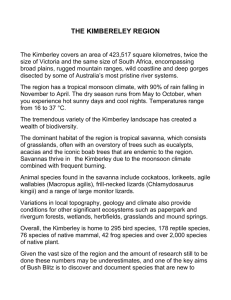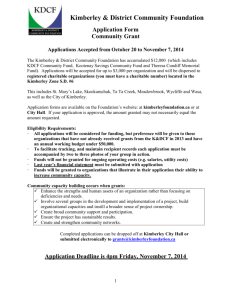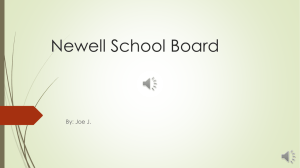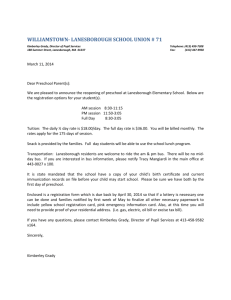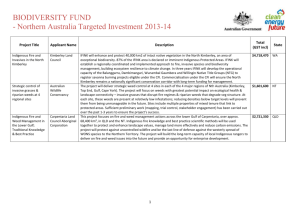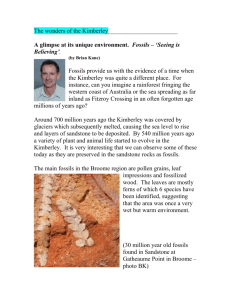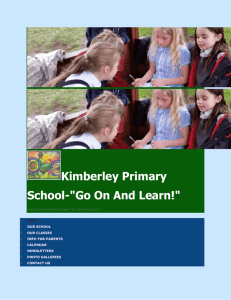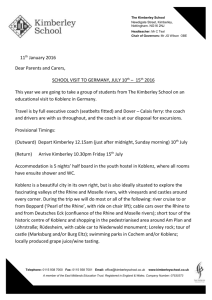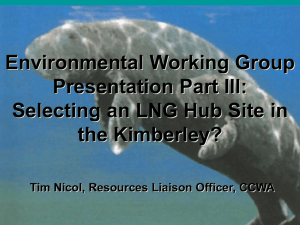available here. - The Kimberley Nature Park
advertisement
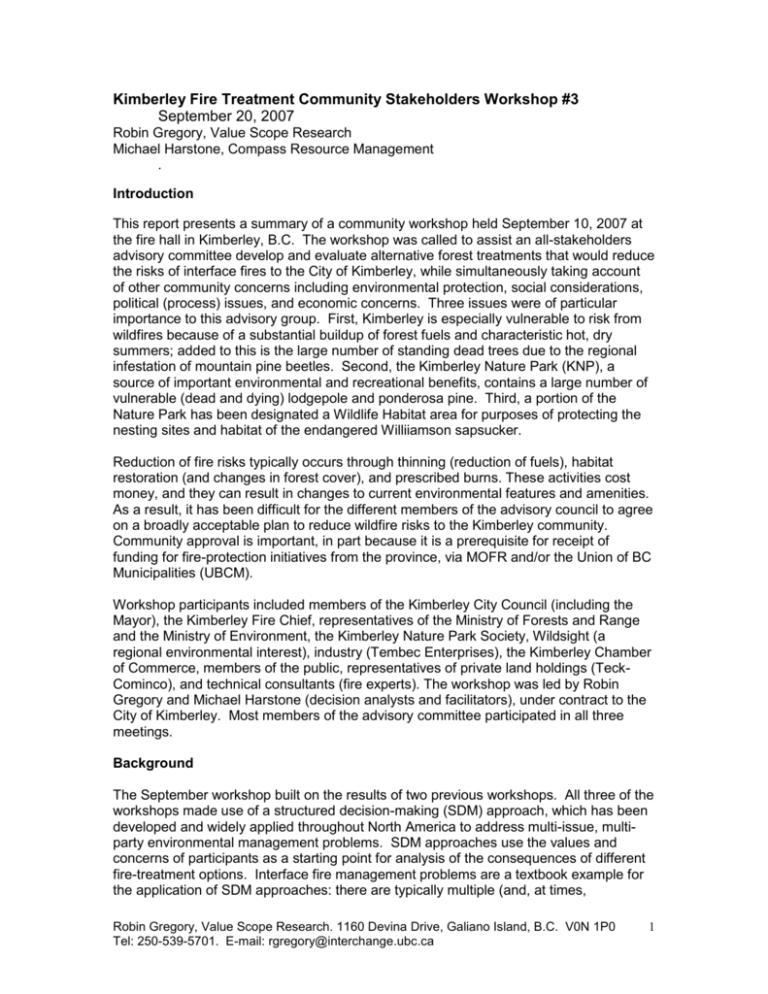
Kimberley Fire Treatment Community Stakeholders Workshop #3 September 20, 2007 Robin Gregory, Value Scope Research Michael Harstone, Compass Resource Management . Introduction This report presents a summary of a community workshop held September 10, 2007 at the fire hall in Kimberley, B.C. The workshop was called to assist an all-stakeholders advisory committee develop and evaluate alternative forest treatments that would reduce the risks of interface fires to the City of Kimberley, while simultaneously taking account of other community concerns including environmental protection, social considerations, political (process) issues, and economic concerns. Three issues were of particular importance to this advisory group. First, Kimberley is especially vulnerable to risk from wildfires because of a substantial buildup of forest fuels and characteristic hot, dry summers; added to this is the large number of standing dead trees due to the regional infestation of mountain pine beetles. Second, the Kimberley Nature Park (KNP), a source of important environmental and recreational benefits, contains a large number of vulnerable (dead and dying) lodgepole and ponderosa pine. Third, a portion of the Nature Park has been designated a Wildlife Habitat area for purposes of protecting the nesting sites and habitat of the endangered Williiamson sapsucker. Reduction of fire risks typically occurs through thinning (reduction of fuels), habitat restoration (and changes in forest cover), and prescribed burns. These activities cost money, and they can result in changes to current environmental features and amenities. As a result, it has been difficult for the different members of the advisory council to agree on a broadly acceptable plan to reduce wildfire risks to the Kimberley community. Community approval is important, in part because it is a prerequisite for receipt of funding for fire-protection initiatives from the province, via MOFR and/or the Union of BC Municipalities (UBCM). Workshop participants included members of the Kimberley City Council (including the Mayor), the Kimberley Fire Chief, representatives of the Ministry of Forests and Range and the Ministry of Environment, the Kimberley Nature Park Society, Wildsight (a regional environmental interest), industry (Tembec Enterprises), the Kimberley Chamber of Commerce, members of the public, representatives of private land holdings (TeckCominco), and technical consultants (fire experts). The workshop was led by Robin Gregory and Michael Harstone (decision analysts and facilitators), under contract to the City of Kimberley. Most members of the advisory committee participated in all three meetings. Background The September workshop built on the results of two previous workshops. All three of the workshops made use of a structured decision-making (SDM) approach, which has been developed and widely applied throughout North America to address multi-issue, multiparty environmental management problems. SDM approaches use the values and concerns of participants as a starting point for analysis of the consequences of different fire-treatment options. Interface fire management problems are a textbook example for the application of SDM approaches: there are typically multiple (and, at times, Robin Gregory, Value Scope Research. 1160 Devina Drive, Galiano Island, B.C. V0N 1P0 Tel: 250-539-5701. E-mail: rgregory@interchange.ubc.ca 1 conflicting) environmental, economic, and social interests; there is uncertainty about fire behavior and timing as well as uncertainty about the effectiveness of treatments; timing and location of efforts both make a great deal of difference; and the sources of the problem are both controllable (e.g., fires caused by careless campers) and subject to external forces beyond our control (e.g., lightning, global climate change). A first workshop of the Advisory Committee, held January 25/26, 2007, presented initial ideas for fuels reduction based on the insights of two fire risk-reduction planning models, FARSITE and FlamMap, that focus on the strategic placement of fire treatments (or SPOTS). After substantial discussion and analysis, the January workshop developed three different fire-treatment alternatives: a status quo (i.e., do nothing different) option, a manual Nature Park treatment option (involving no mechanical harvest), and a third option involving substantial fuels treatment (including mechanical harvest, overstory and understory fuel treatment, broadcast burn, and manual treatment in the WISA WHA. This third option became the baseline for moving ahead, although it was recognized that substantially more information was needed to understand several key issues: where treatments would occur spatially, stand-density implications, the risk-reduction potential of specific treatments, and the availability of short-term and longer-term funding sources. As a result, a technical working group was established to provide guidance on these questions as an input to a second workshop. Workshop 2, held May 28 & 29, began with presentations from the Ministry of Forest and Range, Protection Branch and other participants. The fire consultants then presented output from initial analyses of eight different fire-treatment options, showing different spatial areas of concentration and different residual densities. These alternatives were initially evaluated (via model outputs) in terms of four objectives: - Total treatment cost - Smoke, in the form of tonnes of particulate - Fire behavior, in the form of fire intensity and fire type - Fire effects, in the form of flame length Extensive group discussion and input from the Kimberley NPS and its consultant led to the development of a new proposed alternative, one that would provide for thinning and restoration activities within the Kimberley Nature Park (using a combination of paid and volunteer labour) but also would involve fire-reduction activities in Forest Crowne and the encouragement of FireSmart initiatives within the community. After some discussion, this alternative was introduced as a new alternative. The Advisory Committee then made use of an analysis technique, known as a Consequence Matrix, to evaluate the fire-treatment options in terms of the values and attributes expressed by participants. The group discussion highlighted the following concerns: (a) the time allowed if evacuation of Kimberley residents is required, assuming that fire suppression takes place (b) the residual stand density, following thinning, and how this relates to ecological criteria (c) fire-fighting expenses to the province that could be saved were improved fireprotection actions to be put in place (d) avoidance of the possible loss of tourism revenues if a catastrophic fire were to take place (e) the likely fire-protection benefits associated with enhancing aspen and other deciduous stands in riparian areas in the south-west sections of the KNP Robin Gregory, Value Scope Research. 1160 Devina Drive, Galiano Island, B.C. V0N 1P0 Tel: 250-539-5701. E-mail: rgregory@interchange.ubc.ca 2 (f) the need for ecosystem restoration in the northwest KNP (leading to a reduction in ladder fuels and creation of a fire break through use of prescribed burns) (g) the need to distinguish between commercially viable actions and those firereduction initiatives unlikely to make commercial sense and thus requiring innovative solutions, such as modifications to current provincial forestry regulations or additional funding through subsidization or volunteer labour. As preparation for the proposed third meeting, the consultants introduced a mock exercise that was designed to provide experience to participants in understanding how further evaluation of the alternatives would take place once additional factual information was in hand. This exercise involved presentation of an illustrative (that is, hypothetical but realistic) consequence table that included 9 fire-treatment attributes (concerned with fire management, conservation, financial/economic objectives, and social considerations) and five management alternatives (including a no-action option). Participants were shown how a visual display tool called Vista could help to show the relative pros and cons of the different alternatives through the use of colour-coding relative scores, by alternative, for each objective (red if another alternative scored worse for the objective, green if it scored better, and yellow if it were practically the same). Participants then took part, on an individual (and anonymous) basis, in two activities intended to help them make a choice that reflected their own preferences and the tradeoffs across objectives. First, they ranked and weighted the alternatives (“direct ranking”). Next, they ranked and weighted the relative importance of the objectives, with reference to the range of variation in each objective across the relevant alternatives (“swing weighting”). The display of this information permitted each individual to observe their expressed preferences in comparison to others in the group, as well as the degree of consistency that existed between the two approaches to dealing with tradeoffs. September 10 meeting and results The third and (as widely proclaimed) final meeting of the Advisory Committee took place on September 10. The purpose of the meeting was to review new work on the development of fire treatment alternatives that had taken place over the summer, led by Greg Utzig (consultant to the KNP) and Bob Gray (consultant to the City of Kimberley), and to see whether it would be possible to reach consensus agreement on a plan. A related goal of the meeting, assuming that a consensus plan could be achieved, was to provide advice to the Mayor and Council regarding implementation challenges and their possible solutions. The meeting began with three short presentations. The Ministry of Environment provided an update on their current thinking regarding treatments in the WISA WHA area, including the approximate areas, scale, and timing of treatments that may be permitted within the WHA based on recent field studies. Teck-Cominco provided an update on the fire risk-reduction activities that they are now committed to on Forest Crowne lands. Kimberley’s fire consultant, Bob Gray, presented a review of this summer’s Angora Fire near Lake Tahoe, California; the fire occurred in similar terrain and provides lessons regarding the benefits of treating a larger area (so as to avoid postage-stamp treatments) as well as the need to give special attention to riparian areas and steeper slopes. Robin Gregory, Value Scope Research. 1160 Devina Drive, Galiano Island, B.C. V0N 1P0 Tel: 250-539-5701. E-mail: rgregory@interchange.ubc.ca 3 Greg Utzig, consultant to the KNP, then showed a large map of the KNP to present the basic elements of a new fire-treatment plan that had been worked on over the summer with input from the KNP, MOE, the City of Kimberley, and the fire consultant. The plan, focused on treatments within the KNP, is based on criteria that reflect an ecosystem restoration approach. It was felt that this approach would reduce long-term maintenance costs, meet the fire objectives by reducing crown bulk density and ladder fuels, and meet WISA and other environmental and conservation interests. Although substantial additional analysis still needs to be completed, as noted below, the plan proposes preliminary treatment areas based on aspect maps of the KNP overlaid with slope maps; these will then be refined based on the identification of location-specific values. No treatment is proposed for some areas (generally moist riparian areas and north aspects), with treatments in other areas divided into four major forest types: riparian zones, to be treated to remove infill stems and encourage the regrowth of deciduous components. Trees > 25cm diameter to be retained. open forest grasslands, to be treated by removing infill trees and thinning the overstory to 75-150 stems/ha, also by reintroducing low intensity burning moderately open forest, treated by removing infill trees and shrubs and thinning the overstory to 150-400 stems/ha, with species preference for ponderosa pine and western larch. Also reintroduce low intensity burning. slightly open forest, treated by removing infill trees and thinning the overstory to 400-12000 stems/ha while removing ladder fuels, raising canopy base height, and retaining sufficient shade to retard regeneration and understory re-growth. In general, the plan proposes retention of most of the larger trees, with cuts to occur based on a minimum diameter calculation. The plan also recognizes the need to protect specific wildlife trees in designated areas (such as the WISA WHA and other wildlife tree patches). The fire consultant noted that detailed analysis of this treatment plan had not yet been undertaken. However, he stated his confidence that the plan would meet the minimum fire management requirements that had been expressed by the Advisory Committee with respect to controllability, the probability of an active crown fire, and evacuation time (with suppression). Concerns were expressed by many participants, including not only Tembec but also the City and the KNP consultants, that the plan was likely to be expensive because it would require extensive thinning of non-commercial trees, to be followed by their removal or burning. Following extensive discussion of the pros and cons of the proposed preliminary plan1, and with acknowledgement of the need for extensive additional analyses to move from the current sketch to a more detailed plan, the group worked to develop a statement that would capture the progress made to date on development of a consensus fire treatment plan. The following wording was agreed to by all participants: 1 Including consideration of how well the plan performed relative to fire risk reduction, meeting conservation values in the KNP (related to the ecological appropriateness and density of the residual stand structure), recreation and tourism and aesthetic concerns, smoke generation, concerns raised about health impacts, public acceptability, and the financial implications of the plan over the short-, medium-, and long-term. Robin Gregory, Value Scope Research. 1160 Devina Drive, Galiano Island, B.C. V0N 1P0 Tel: 250-539-5701. E-mail: rgregory@interchange.ubc.ca 4 The Stakeholder Advisory Committee established by the City of Kimberley today reached agreement on an over-arching interface fire plan. If implemented, the plan – which is based on principles of ecological restoration – would significantly reduce fire risks to the City, address the mountain pine beetle infestation, and protect conservation values in the Kimberley Nature Park. Participants on the Advisory Committee included the City of Kimberley, the Kimberley Nature Park Society, the Ministry of Environment, the Ministry of Forests and Range, the Chamber of Commerce, Wildsight,Teck-Cominco, and the City’s fire consultant. The licensee, Tembec Enterprises, abstained due to concerns about economic viability based on MOFR’s current tenure and appraisal system. The Advisory Committee emphasized that significant economic funding hurdles need to be overcome before implementation of the plan is feasible. The agreement on this statement and the willingness of all participants to proceed with the next steps toward implementation of this plan is viewed by members of the Advisory Committee as an important step forward. However, as echoed in the statement shown above, significant concerns exist regarding implementation feasibility. As a result, the rest of the September 10 meeting was spent discussing the following key implementation priorities. 1. Need for additional analysis. Several types of analysis still need to be completed in order to provide necessary details and a full understanding of the implications of the over-arching plan. These analyses include a. fire-model analyses, to be completed by the fire consultant; b. a discussion of the process followed to date and a clearly-worded report that links the identified fire-treatment alternatives to the concerns and objectives expressed by the Advisory Committee participants. This report also should clearly note the steps that have been taken to reduce conflict among participants and to develop an over-arching agreement; c. completion of the draft consequence table, showing fire-treatment alternatives and the set of objectives (addressing fire reduction, social, economic, and conservation concerns), that has helped to guide discussions of fire-treatment options (see attached illustrative table); d. a cost-benefit analysis, to be conducted by the Province, that should include not only the costs and benefits associated with the proposed treatment plan but also the costs averted by reducing the fire hazard faced by the City of Kimberley and the long-term benefits associated with movement toward more ecologically appropriate stand types (e.g. initial costs versus ongoing maintenance costs) e. additional analysis of those areas within the KNP where an economically feasible harvest of timber could take place (such as some portion of the open forest stands). f. more detailed landscape level plans need to be developed to better highlight amount of thinning by area, access and ancillary roads/trails, landings for skidding and turnarounds, etc. 2. Location of initial treatments. Three priority areas to begin the treatments were agreed to at the September 10 meeting: i) begin closest to the city, ii) focus on the merchantable pine beetle timber (in the south), and iii) access areas for fire suppression. 3. Improved road access. Permanent road access for key areas also needs to be improved, so that the Kimberley Fire Department can quickly and safety enter the Robin Gregory, Value Scope Research. 1160 Devina Drive, Galiano Island, B.C. V0N 1P0 Tel: 250-539-5701. E-mail: rgregory@interchange.ubc.ca 5 4. 5. 6. 7. 8. 9. Park should a fire start. After discussion, a general agreement was reached on the location of main access roads. It was acknowledged that secondary road access is also critical, and further discussions are to take place in the near future. An access road is also required for the WISA habitat area. Initial treatment costs. All participants agreed that substantial thinning of noncommercial timber needs to occur, and that there will be insufficient timber of commercial sizes and grades to offset the non-merchantable removals. In addition, some of the costs associated with post-harvest reduction of fire hazards, such as piling and burning of slash, are expected to be significant. Although further analysis of the costs associated with the Plan are needed, it was estimated that the total costs for implementation could be as high as $6 – 13 million assuming limited cost recovery from timber sales. Ongoing maintenance costs. Ongoing maintenance would involve both controlled interface burning and thinning. In earlier meetings, it was suggested that volunteers from the Kimberley Nature Park might be able to be involved and thus offset some of the associated costs. Nevertheless, funding needs to be secured for ongoing maintenance or else interface fire problems will simply reappear after a short period of time. Annual maintenance costs were estimated at ~$150,000/yr. WorkSafe B.C. issues. These concern the risks to both the public and forest workers in proximity to snags. Implications of the proposed plan for current policies followed by the MOFR. In particular, several participants noted that key elements of the treatment plan adopted by the Advisory Committee are inconsistent with portions of the existing tenure and appraisal system; in particular, participants noted that there is a need to establish a separate tenure system specific to harvesting areas to reduce wildfire risks and fund their implementation. In the view of Committee members, these portions of existing provincial legislation will require amendment in order to facilitate reduction in the risks of interface fires such as those proposed by Kimberley’s Advisory Committee. Other seemingly incompatible provincial policy issues were highlighted during the deliberations and these would have to be resolved before the Kimberley plan was adopted (for example, once a wildfire interface area is acted upon, it will effectively remove this area from the timber harvestable land base). Implications of the proposed plan for other interface fire communities within British Columbia. One of the participants noted that some 1.75 million hectares of interface forest have been identified in BC, and the decision process and overarching treatment plan developed for Kimberley may be relevant for some portion of the associated communities. Additional funding for further treatments within the WISA WHA, to be requested from their Ministry by the MOE representatives. The meeting closed with each participant noting their perspective on next steps and discussing the pros and cons of the structured decision-making process that had been followed. The Mayor then stated that he had all the information needed from the Advisory group before going back to Council for further discussions, and the meeting was adjourned. Attachments: Illustrative Consequence Table Robin Gregory, Value Scope Research. 1160 Devina Drive, Galiano Island, B.C. V0N 1P0 Tel: 250-539-5701. E-mail: rgregory@interchange.ubc.ca 6 Direction Units Illustrative Consequence Table: Kimberley Fire Treatment Workshop 3 Fire Mgt scale) L # Fire Mgt Probability of Active Crown Fire L % Fire Mgt Evacuation Time w/Suppression H hr Residual Stand Conservation Density (AVG) H # Ecol. Appropriate Conservation Stand Type H # Probability of longterm protection of Conservation WISA WHA H % Performance Measure B J A Tembec Plan September 10 No Consensus Plan Action (453) Controllability (6 pt (10 pt scale) Financial Initial Treatment Costs L $M Financial Ongoing Maintenance (NPV) L $M Financial Economic Harvesting H $M Financial Uneconomic Harvesting L $M H # L t Social Social Recreation & Tourism Quality (10 pt scale) Smoke (AQ): aesthetics and health Robin Gregory, Value Scope Research. 1160 Devina Drive, Galiano Island, B.C. V0N 1P0 Tel: 250-539-5701. E-mail: rgregory@interchange.ubc.ca 7
